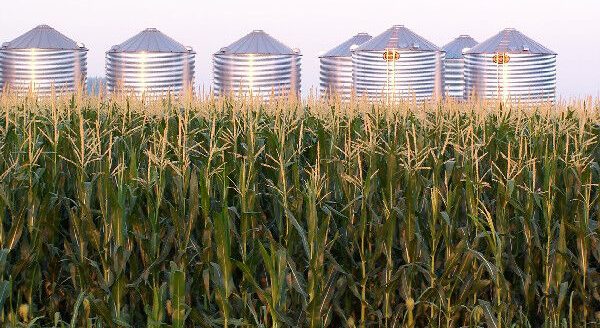On-farm storage provides flexibility if right questions are asked
In an era of lower crop prices and excess grain, High Plains producers may explore increasing their storage capacity.
Experts who regularly work with farmers and workers say producers need to look at storage and marketing as linked opportunities.
“The current carries in the futures market along with depressed basis in many areas expands opportunity to earn a return to on-farm storage,” said Roger Fray, a buyer relations manager at AgWest Commodities, Holdrege, Nebraska. “That is not always the case, so, yes, the environment is more positive now than in other times due to high carry stocks-to-use ratios.”
Built for the right reasons and managed well, it can be a good investment both for logistics management and for marketing returns, he said.
“We work hard to educate our clients on how to manage their on farm space much like a commercial elevator does,” said David Bohm, AgWest Commodities’ cash marketing alliance program director. “Most times this means having hedged grain in a bin versus unsold grain.”
Ann Johanns, an Extension program specialist at Iowa State University, said there is a balance in investing in new storage while considering cost savings.
“An investment in grain storage is a long-term decision for an operation and shouldn’t be based on the short term,” she said, adding if producers are looking to trim costs a large investment in storage capacity isn’t likely in the cards. “If they were already considering increasing their grain storage options, potential expanding their market opportunities, than it is a matter of looking at the specific costs and if that is feasible for that particular farm business.”
Johanns encourages producers who are evaluating whether to expand their operation’s capacity or explore commercial or cooperative opportunities to look at www.extension.iastate.edu/agdm/crops/xls/a2-35.xlsx.
Before looking at expansion, producers need to look at future goals they might have for their enterprise, she said.
The first step is for a producer to consider all storage options and that includes considering the marketing plan and business goals in the long term.
Benefits of on-farm storage include:
-
Grain prices to be higher later in the marketing year than at harvest and storing grain can help capture the “carry” in the market;
-
Flexibility in where and when grain is sold can be maintained;
-
Harvesting may progress faster if grain does not have to be delivered to an off-farm location directly from the field; and
-
Grain may be used gradually throughout the year for livestock feed.
-
Johanns said that also means producers will likely have additional requirements to maintain quality, extra handling, drying and shrinkage.
-
Producers also need to evaluate their capacity to transfer grain and ship it and also if they have the right handling equipment to efficiently handle the grain.
Sign up for HPJ Insights
Our weekly newsletter delivers the latest news straight to your inbox including breaking news, our exclusive columns and much more.
Marketing goes hand-in-hand
“Increasing on farm storage is a good idea, if you know how to manage the storage in tandem with marketing opportunities,” said Naomi Blohm, a marketing advisor with the Stewart-Peterson Inc., based in West Bend, Wisconsin. “All too often we see producers who store their crop at home, and still have trouble pulling the trigger on sales. Be mindful that if you store your crop at the end of harvest, realistically, your best marketing opportunities, seasonally, lie between mid-winter and early summer. Use those pricing opportunities to market your crop.”
Adding on farm storage means taking a look at what objectives need to be accomplished.
In terms of carry and basis gains, in that light, Fray said that can serve as a trigger point for producers to commit to increasing on-farm capacity. “We have large carry outs and a positive return to ownership of grain. Building to sell for a higher ‘flat price’ without specific objectives is not as strong of a plan and can actually increase risk and provide negative returns.”
“Often times as an operation grows they may not have the additional manpower needed to deliver grain at harvest time to their local elevator,” Bohm said. “It seems like everyone has a different set of mathematics when it comes to what the actual value is for this convenience so the value can be a moving target.”
Bohm agreed with his colleague that merely building storage to avoid actually selling grain on opportunities more times than not is not a good plan.
Storage options
Analyzing on-farm versus commercial or common, shared storage is a must.
“This is really an individual decision and varies by geography and by crop,” Fray said.
Many areas are well served with efficient assets while in other areas local buyers have not kept up with harvest capacity or competitive service charges, Fray said. A producer usually knows instinctively if harvest is constrained by receiving capacity. Service charges, however, require a little more analysis versus the cost of building on-farm capacity. Fray and Bohm said multiple questions do arise.
Questions to ask include “Is my harvest pace limited by access to reliable commercial capacity?” and “Do I have a working knowledge of or a trusted partner to manage basis and future spreads risk after construction?” “How long am I willing to carry corn on farm?” “What time frame post-harvest generally gives me the best basis return?” “Over the last five years what would have the average return to space been if I would have a moved a third of my hedged corn in March/May and July?” “Is my lender on board with loaning the money to manage this inventory?”
“If grain is currently marketed from the field, that money is available immediately, for grains that is stored, there might be an increase in interest expense with funds tied up in grain inventory,” Johanns said.
Blohm said if she was a producer she would ask herself, what is the per bushel break down of building on farm storage over the cost of a year, or even over a decade, and compare that to what an elevator would charge. Compare logically if it makes sense to build at home—will it make harvest go faster? Can you take the grain to town in winter or early spring with any road restrictions? Are you ready to be able to properly care for and manage the actual grain in storage?
“You still have to price the grain,” she said. “You might feel smart about not paying ‘storage costs or rolling fees’ at the elevator, but you need to know when and how to price your grain. Period.”
Adding profits key
Producers need to recognize this is a good opportunity to review marketing strategies as it pertains to potential added profits and revenue in light of on farm storage decisions, Blohm said. Be mindful of seasonal tendencies to market prices when it is logistically feasible to move stored grain from farm to town and be mindful of the times when the operation needs cash flow.
“Having a bin at home doesn’t change any of the above, but it absolutely makes it more critical that you have the discipline to make those cash sales when the marketing opportunities present themselves,” Blohm said.
There is a cost to storage—whether it is at the elevator, or whether the producer is doing it on his own at home, she said.
Fray said, “I have worked with successful producers who chose early not to build on farm storage and who have grown and prospered without it, along with others who have successfully stored grain on farm for years. A good marketing plan allows for all scenarios and annual execution plans with the individual producer.”
Sharing space
Some producers have creatively looked at sharing storage resources with a neighbor as a way to save costs and the idea has merit, Johanns said. Such arrangements require due diligence by all parties and it is essential to get everything written down.
“Any agreement where a crop might be comingled needs to be in writing so both parties can clearly read what they have agreed to and be able to look at if questions come up in the future,” Johanns said.
Questions that arise include:
-
With the location of the structure, does one person own it and the other rents the space or do they both invest in it together;
-
Who maintains and takes on the risk associated with grain quality.
Another question that revolves around commingled grain “Do the parties have to agree on marketing decisions together or can they do so separately and who will maintain the records?”
Johanns said any agreement needs an exit plan by either party and she recommends that a third-party expert review it before entering into an agreement.
Type of structure
A producer should research various structures and technology, costs for all types to determine the best fit for him, Johanns said. Drying systems might also need to be considered in addition to the structures.
Some producers might be able to move an existing bin, she said the producer needs to look all aspects. What condition is the existing storage in and how it has been used and maintained? A foundation will be needed before a new or used facility is placed. Other expenses also have to be taken into account, including the cost for drying, labor for maintaining the crop in storage and a shift of the labor pool when transporting crops to the market.
Infrastructure questions
“In some or many cases the addition of on farm storage reduces and/or eliminates labor needs during time sensitive harvest,” Fray said. “There is an added off-season labor requirement but is usually more manageable. The definition of ‘market when grain prices are higher’ has to be clear. Good pricing opportunities are sometimes available pre-harvest, and post-harvest highs are sometimes evasive. Storage bins allow control of return to storing the grain, not control of future prices. The working capital decision is also an individual one. Current low rates combined with strong basis opportunities support building space, but not if it threatens the remainder of the operation by constraining working capital.”
Johanns said producers should regularly evaluate their entire farm operation to see what areas are slowing down the efficiency and if the equipment is sized correctly as well as drying systems and storage availability. They should ask themselves if there is a bottleneck. Other questions should be is the storage capacity the appropriate size for the operation and should lead growers to an important follow up question—Are crops currently marketed from the field or stored commercially? If on-farm storage was built, how would that benefit the entire operation and how would the marketing plan change?
Keep it all straight
Bohm said trying to store grain with the sole idea of marketing when prices are higher maybe employing the wrong thought process. “I would say many times this can cost you money. A few years back when we had less carryout and more volatile markets that would have been true but the last couple of years way too many folks put unpriced grain in a bin waiting for it to go up when in fact it did not.
“With our clients putting grain in the bin that is hedged allows us to react to the market and do what it is telling us, i.e. in times of excessive supply the basis will get wider than normal and the futures spread generally will work wider allowing the hedged producer to roll their hedges out to deferred futures months earning the carry while waiting for basis opportunities.”
Dave Bergmeier can be reached at 620-227-1822 or [email protected].




